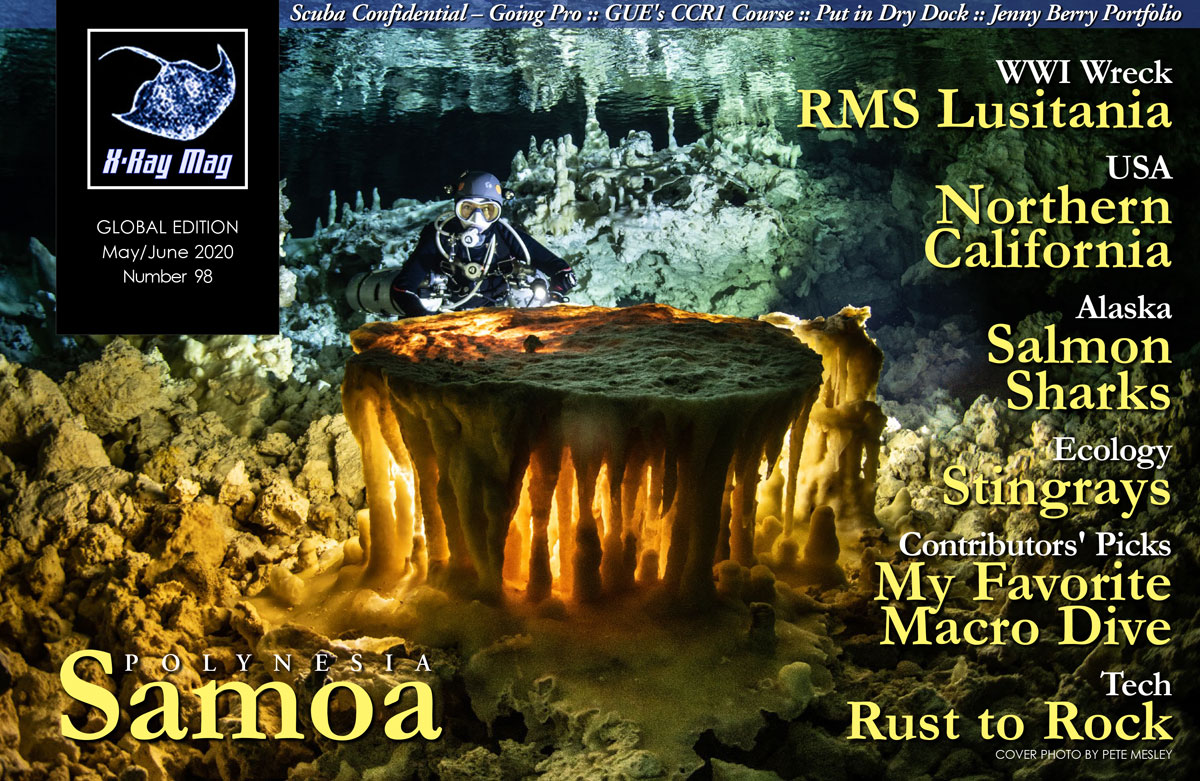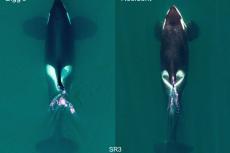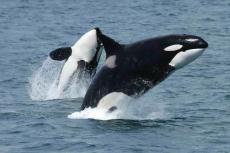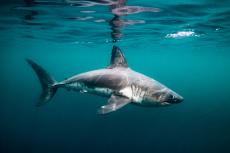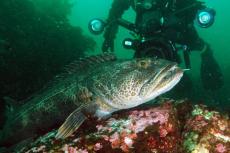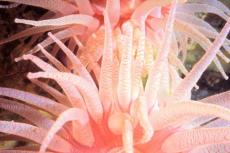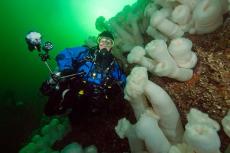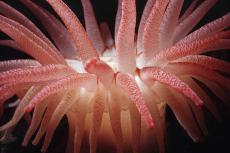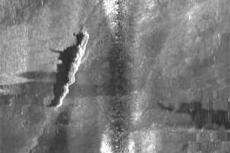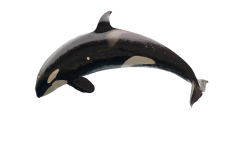Sharks elicit strong emotions, be it the thrill of a planned encounter underwater or fear propelled by social media and lack of information. Of the more than 400 species of sharks, it is the small family of mackerel sharks that is most iconic. These sharks prompted me to share why one of them, the salmon shark, is an especially remarkable species.
Contributed by
Why sharks? Seeking encounters with sharks has become a mild obsession of mine, and sharing their story is deeply personal. My interest in sharks was spurred by years of diving and not seeing sharks on those dives. The few sharks I did see were mostly nurse sharks, which did not conjure the same kind of excitement as sharks typically depicted in movies and media. It was the brief glimpse of a bull shark in the Florida Keys that grabbed my imagination.
I also became curious about the motivations behind people’s thirst for the thrill of seeing sharks and for fearing them. During the journey I took diving all 50 states of the United States, I continued to encounter few sharks. I saw a number of rays, part of the subclass that comprises sharks (Elasmobranchii), and adorable horn sharks, but only heard tales of encounters from other divers about other species. Their stories put purposeful encounters with sharks at the top of my bucket list.
Some of my fascination with sharks can be attributed to my grandparents, who prohibited me from seeing the movie Jaws, the single most recognized media icon for promoting widespread fear of sharks. I still have not seen it. More recently, Discovery Channel's Shark Week seems to feed on fascination driven by fear. Though educational and inspirational intent is at the heart of most programming, it is my impression that the viewers’ main takeaway from watching these programs is the thrill of watching frightening shark behavior rather than gaining respect for a prehistoric wonder. How do we educate and illuminate audiences about a species that we love for its evolutionary feats and its recognizable teeth?
Answering these questions and fulfilling my dreams to encounter sharks began in Alaska, at the end of my 50-state journey, where I learned about the fabled salmon shark (Lamna ditropis). I learned there was an operator in Prince William Sound, which offered trips to swim with them, and so I made plans that directed the next five years of my diving career.
Finding the town of Valdez
I signed up for my first trip with Ravencroft Lodge through shark expert Andy Murch of Big Fish Expeditions. Boone Hodgin now runs North 60 Adventures from his remote lodge to take a limited number of guests to encounter sharks each summer. He meets guests in Valdez and makes the crossing from Prince William Sound to Port Fidalgo. To get to the small fishing town of Valdez, I prefer to fly into Anchorage and then make the five-hour drive.
Alaska is one of America’s last great wildernesses and home to grizzly bears, melting glaciers, salmon and bald eagles. Summers are a flurry of life, rushing to reproduce and eat while food is plentiful. Making the crossing to Valdez afforded me the opportunity to see sites such as Matanuska Glacier and Horsetail Falls.
Valdez is a tiny town whose name is recognizable from the Exxon Valdez oil spill in 1989, which originated from these waters. An earthquake in 1964 caused a tsunami that nearly wiped out the town and resulted in the construction of the modern marina, from which we depart today. Glaciers surround the town and are the source of the murky teal glacial waters seen near shore.
Salmon sharks and their relatives
Before any expedition, I research as much as possible about my subject to ensure the best encounters. Little is known about salmon sharks, but what I found correlated with what is known about all sharks. They are poorly protected, comprising part of an average 100 million sharks killed each year.
The salmon shark population was estimated at two million individuals in 1989 with poorly documented catches, showing that during some years, nearly 200,000 individuals were caught within a four-month window. Though they are listed as of “least concern” with the IUCN Red List, it is noted that this assessment is based on a lack of evidence regarding current populations and on reduced numbers of catches. Sport fishing for salmon sharks is prevalent in Alaska, with reports of a single competition killing 10,000 salmon sharks in Valdez around the year 2000.
Salmon sharks are distinct, and at the same time, part of the most recognizable shark family. They belong to the family of mackerel sharks (Lamnidae), which also include great white sharks, shortfin and longfin mako sharks, and porbeagle sharks. They are remarkably adapted to their cold-water habitat and also share the uncommon characteristic of being endothermic, meaning they can keep their body temperature above the water temperature. This is especially helpful for when they mate in the Arctic.
Observing salmon sharks
Our group of divers waited patiently to observe sharks in the morning from Ravencroft Lodge. The sharks are frightened by movement in the water, so we entered the water as quietly as possible and hid beneath small boats to reduce our footprint. While we observed them swimming leisurely, it was important to keep in mind that these were the fastest sharks in the world, as determined by recent observations by the US Navy, recording salmon sharks swimming more than 80km/h (50mph). Streamlined bodies propel them through the water with astonishing efficiency, which means they can swiftly vanish from encounters.
It was my first glimpse of a salmon shark reaching for bait that hooked my love for them. The full-throated view only appears when the shark is feeding. It is a desirable behavior for photography, and because these are deep-feeding sharks, up to 600m (1,969ft), we cannot observe their natural feeding behavior.
To find a salmon shark with which we could enter the water, we looked for the dorsal fin at the surface and watched the shark’s movements. A leisurely shark swimming in circles is a good sign that the shark might not disappear before we can observe it in the water. A single herring was used to keep the shark interested in staying long enough for a group to observe it. Salmon sharks in Alaska feed on herring, one of the fish populations disrupted by the Exxon Valdez oil spill.
In every year I have returned to observe salmon sharks, I have seen new behaviors, such as watching them rub against floating logs and even seeing two unexpectedly leap out of the water. Mackerel sharks are famous for their breaching behavior, but seeing this in salmon sharks has been less commonly observed.
They are beautiful sharks whose main predators are humans and some orcas. Unlike ground sharks such as tiger sharks, mackerel sharks such as the salmon shark do not have a nictitating membrane—a type of retractable eyelid. I find salmon sharks adorable with their wide, round faces and overly large eyes, useful for navigating deep water. They are a species of shark worth the investment in a trip to encounter them in their natural habitat.
Regional habitat
Salmon sharks are part of a rich ecosystem throughout Alaska and the North Pacific. While we observed them in Port Fidalgo, they have been known to travel as far south as Northern California and as far west as Russia and Japan. Their feedstock is more varied than their common name suggests and includes herring, squid and salmon, among the dozens of fish they feed upon.
They leave Port Fidalgo before salmon spawning reaches peak season. The port itself is protected by mountainous landscape akin to the fjords of Norway and Iceland. It is a deep body of water in which I have seen orcas, Dall’s porpoises, sea otters and even a mule deer swimming through.
Since salmon sharks are only observable in the morning, afternoons on salmon shark trips are spent photographing bald eagles diving for herring, or getting in the water with other wildlife. The Pacific Northwest is rich with life above and below water and includes large invertebrates such as hooded nudibranchs bigger than your hand. In late summer, moon jellies bloom for their reproductive cycle. Their mass gatherings can reach below recreational diving depths and spread across wide bodies of water.
The future of salmon sharks
Opportunities to encounter salmon sharks are rare and only commercially offered through Ravencroft Lodge with North 60 Adventures. They are a subject I will never tire of seeing, and I will continue working to educate people about how these special, endothermic sharks are an important part of our ecosystem.
We know little about the full extent of their behavior and can make observational inferences, but an important attribute of these and all sharks is that they help maintain ocean health by removing weak and sick animals.
I want to be able to dive with and document our sharks for a lifetime and not just document their history. Improved understanding of sharks, bans on shark-finning and fishing, and limits to wasteful fishing practices with bycatch, are all steps to maintaining healthy biodiversity. ■
A widely published dive writer and underwater photographer, Jennifer Idol is the first woman to dive all 50 US states, which is chronicled in her book, An American Immersion. She has been an avid diver for 25 years, earning more than 29 certifications. A native Texan, she creates design and photography for her company, The Underwater Designer. To see more of her work, visit: uwDesigner.com.
REFERENCES
Anderson, S. D., and Goldman, K. J. (2001). Temperature measurements from salmon sharks, Lamna ditropis, in Alaskan waters. pp. 794-796.
Cvrkel, B. (2013). New study says 100 million sharks killed annually. The Pew Charitable Trusts pewtrusts.og
Hodgin, B. Salmon sharks with Boone Hodgin. North 60 Adventures. ravencroftlodge.com.
IUCN Red List. Salmon Shark. iucnredlist.org.
Murch, A. The taxonomy of sharks and rays. Elasmodiver. elasmodiver.com.
Nagasawa, K. (1998). Predation by salmon sharks (Lamna ditropis) on Pacific salmon (Oncorhynchus spp.) in the North Pacific Ocean. National Research Institute of Far Seas Fisheries, Fisheries Agency of Japan. pp. 419-433.
Skomal, G. (2008). Shark Handbook. Cider Mill Press Book Publishers. pp. 39, 40, 161, 168, 176-178.
Wright, B. (2016). Environment Alaska. Salmon Sharks in Alaska. environmentalaska.us.



